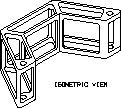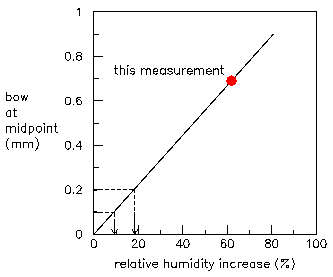FROM BOWING TO HUMIDITY
 Rohacell expands with ambient relative humidity. The level of expansion is of
order 1 part in 10**4 for each percent relative humidity change. This would
not be a big deal if the expansion were uniform, but Silicon glued onto all
three inner surfaces, but not onto 2 of the 3 outer surfaces constrains the
expansion.
There is information on the relation between humidity and cage expansion in Eric's Rohacell paper. For a relative humidity increase from 30%
to 92%, the cage width expands by 0.62% if the foam is free, like on the outer
surface, but only by 0.21% when Silicon is glued on. The picture below shows
this effect:
Rohacell expands with ambient relative humidity. The level of expansion is of
order 1 part in 10**4 for each percent relative humidity change. This would
not be a big deal if the expansion were uniform, but Silicon glued onto all
three inner surfaces, but not onto 2 of the 3 outer surfaces constrains the
expansion.
There is information on the relation between humidity and cage expansion in Eric's Rohacell paper. For a relative humidity increase from 30%
to 92%, the cage width expands by 0.62% if the foam is free, like on the outer
surface, but only by 0.21% when Silicon is glued on. The picture below shows
this effect:

If we now line up 8 of these cages (the outer 4 have silicon on all sides, and
are not expected to contribute), they form the bowed assembly that we are
worried about.
A schematic diagram of half of the arc is shown below.
 |
Here alpha = (8x0.094)/2 degrees, and
d = 4 cagewidths, about 21 cm.
The total bow is d(1-cos(alpha))/sin(alpha) = 0.07 cm
|
If we assume the effect is linear, as I do in the figure below, we can put the
5% and 10% limits, calculated on the previous page,
on the plot below, and derive maximum humidity excursions.
 |
The bowing limits, derived on the previous page, can be translated into
constraints on longterm humidity excursions of 9 and 18 % for the 5% and
10% efficiency losses, respectively.
|
 Rohacell expands with ambient relative humidity. The level of expansion is of
order 1 part in 10**4 for each percent relative humidity change. This would
not be a big deal if the expansion were uniform, but Silicon glued onto all
three inner surfaces, but not onto 2 of the 3 outer surfaces constrains the
expansion.
There is information on the relation between humidity and cage expansion in Eric's Rohacell paper. For a relative humidity increase from 30%
to 92%, the cage width expands by 0.62% if the foam is free, like on the outer
surface, but only by 0.21% when Silicon is glued on. The picture below shows
this effect:
Rohacell expands with ambient relative humidity. The level of expansion is of
order 1 part in 10**4 for each percent relative humidity change. This would
not be a big deal if the expansion were uniform, but Silicon glued onto all
three inner surfaces, but not onto 2 of the 3 outer surfaces constrains the
expansion.
There is information on the relation between humidity and cage expansion in Eric's Rohacell paper. For a relative humidity increase from 30%
to 92%, the cage width expands by 0.62% if the foam is free, like on the outer
surface, but only by 0.21% when Silicon is glued on. The picture below shows
this effect:




![[Up]](arrow.marble.up.gif)
![[Next]](arrow.marble.right.gif)